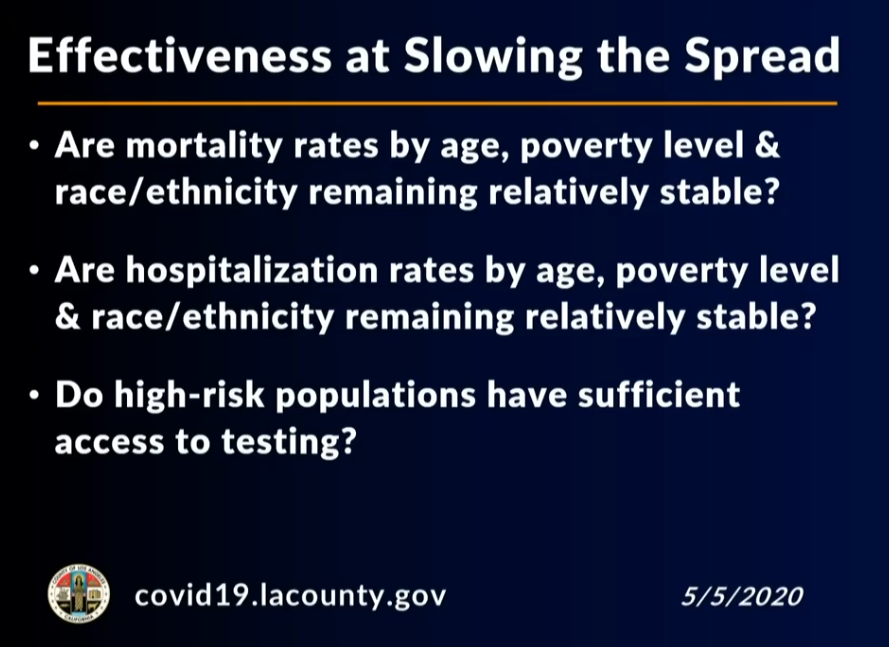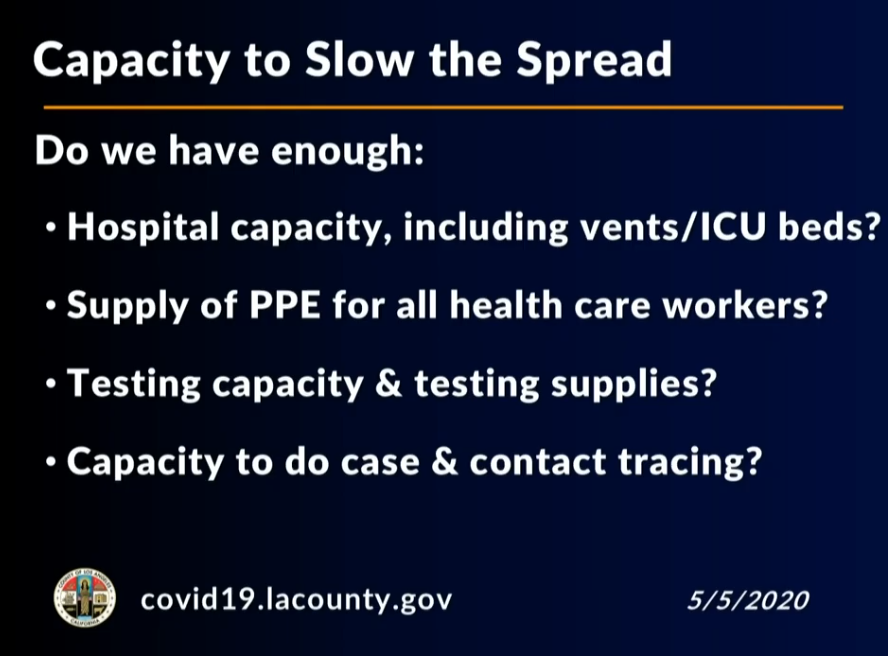Los Angeles County officials on Tuesday revealed they will be tracking numerous factors ahead of reopening the economy and said they will release specific guidelines businesses and individuals can follow later this week.
Public health officials will be examining mortality and hospitalization rates by age, poverty level, and race and ethnicity, as well as making sure high-risk populations have sufficient access to testing.

Additionally, they will make sure they have enough hospital capacity, including ventilators and intensive care unit beds, personal protective equipment, testing capacity and supplies, and the capacity to do extended case and contact tracing.
Barbara Ferrer, the county’s public health director, said as businesses start to reopen and as residents start to slowly return to normalcy, it is important that deaths don’t spike and hospitalization rates remain steady.
“Protecting the people who are most vulnerable is paramount through the reopening process and we all have to do our part to make sure that we’re protecting each other,” Ferrer said.
Last week, California’s weekly death toll fell for the first time, according to a Los Angeles Times data analysis.

Additionally, L.A. County, home to more than half of the state’s coronavirus deaths, also saw its weekly death toll flatten for the first time, the newspaper reported.
On Tuesday, the county had a total of 27,815 coronavirus cases with 1,313 deaths.
While Gov. Gavin Newsom said Monday that low-risk businesses can start to reopen with modifications as early as Friday, it might take longer for Los Angeles, Mayor Eric Garcetti said.
Similarly, on Tuesday, Ferrer said that while L.A. County will follow the governor’s framework for reopening, local officials and residents have a responsibility to be able to do so safely.
She noted that the virus hasn’t gotten less deadly or less infectious since March, and therefore reopening must be done thoughtfully so cases don’t spike.
“One of the saddest things would be to reopen too quickly, not only see too many deaths and too many hospitalizations, but also have to go back and tell businesses to close again,” Ferrer said. “I think we need to do everything we can to be on a steady slow path for recovery that makes sense for L.A. County.”
L.A. County by the numbers
Ferrer noted Tuesday that 93% of the people who have died from COVID-19 had an underlying health condition. The respiratory illness can particularly affect people who have an illness that may not be under control, like obesity, diabetes and kidney disease, especially those who are under dialysis.
Of the fatal cases where race and ethnicity were tracked, coronavirus continues to kill African Americans and Pacific Islanders at a much higher rate, Ferrer said.
There are now 199 cases of coronavirus among people experiencing homelessness. Most of those cases are among people who are sheltered, and the majority of homeless people who tested positive and where sheltered lived at the Union Rescue Mission in Skid Row, where staff and guests are being tested.
Officials are investigating 342 county facilities with at least one confirmed or suspected case of COVID-19, Ferrer said.
A total of 6,521 people in these institutions have tested positive, with 4,044 being residents and 2,477 staff members.
As of Tuesday, 647 people living in an institution have died, the majority of which lived in a skilled nursing facility; they now account for 49% of all deaths in the county, Ferrer said. She said the figure was “alarming” and that officials continue to try and slow the spread of the illness in institutional settings.
Officials are working to test every single employee and resident at nursing homes and assisted living facilities with or without outbreaks, and will soon be doing “surveillance testing,” where a percentage of employees at these facilities will get tested fairly regularly.





















